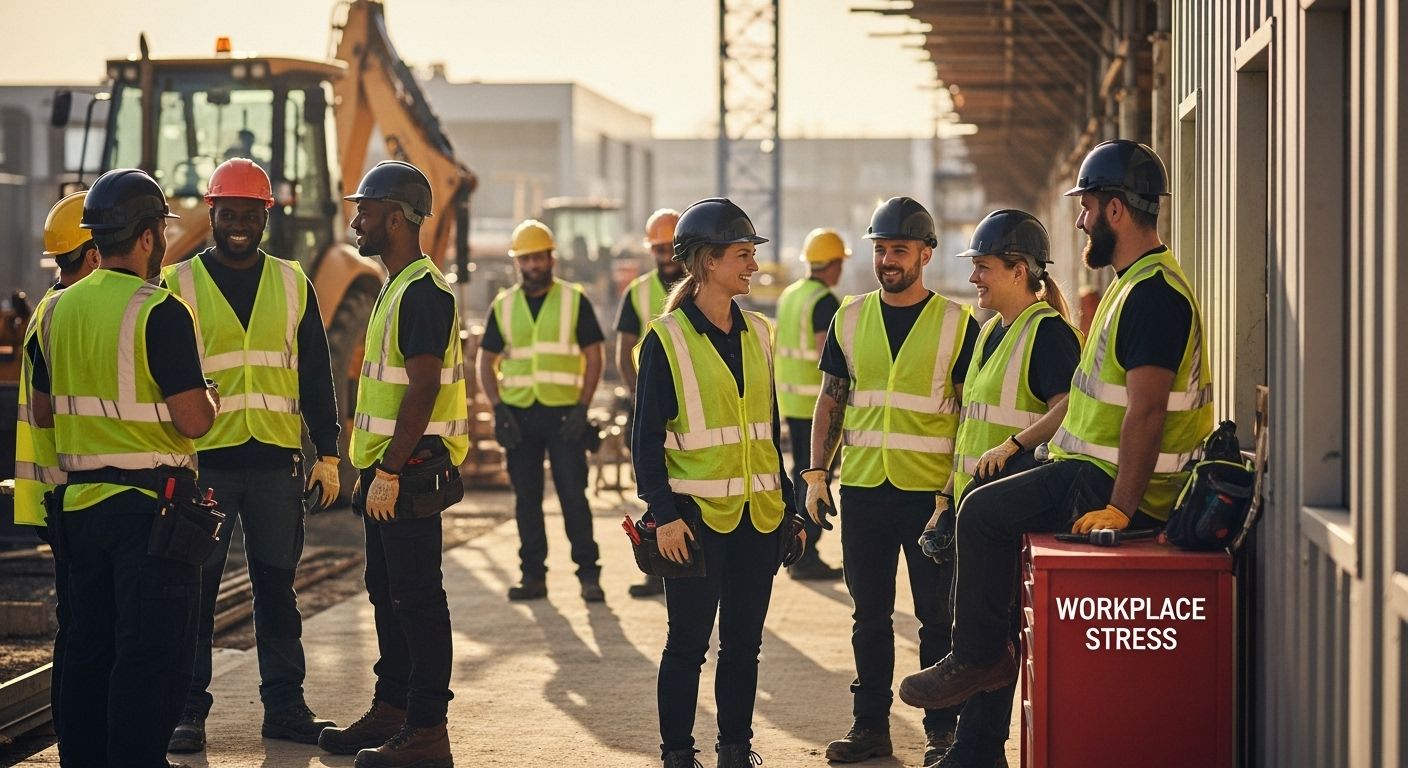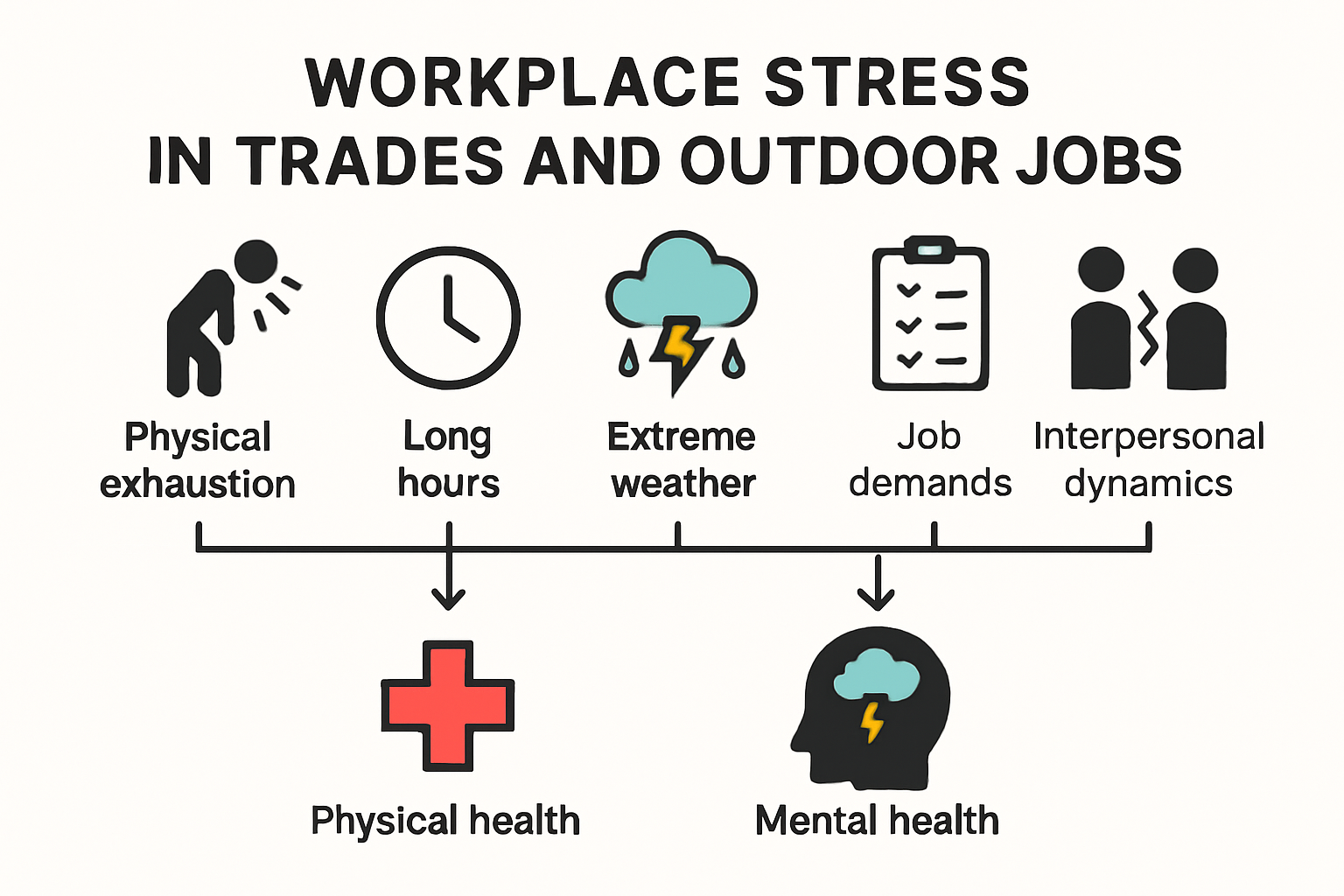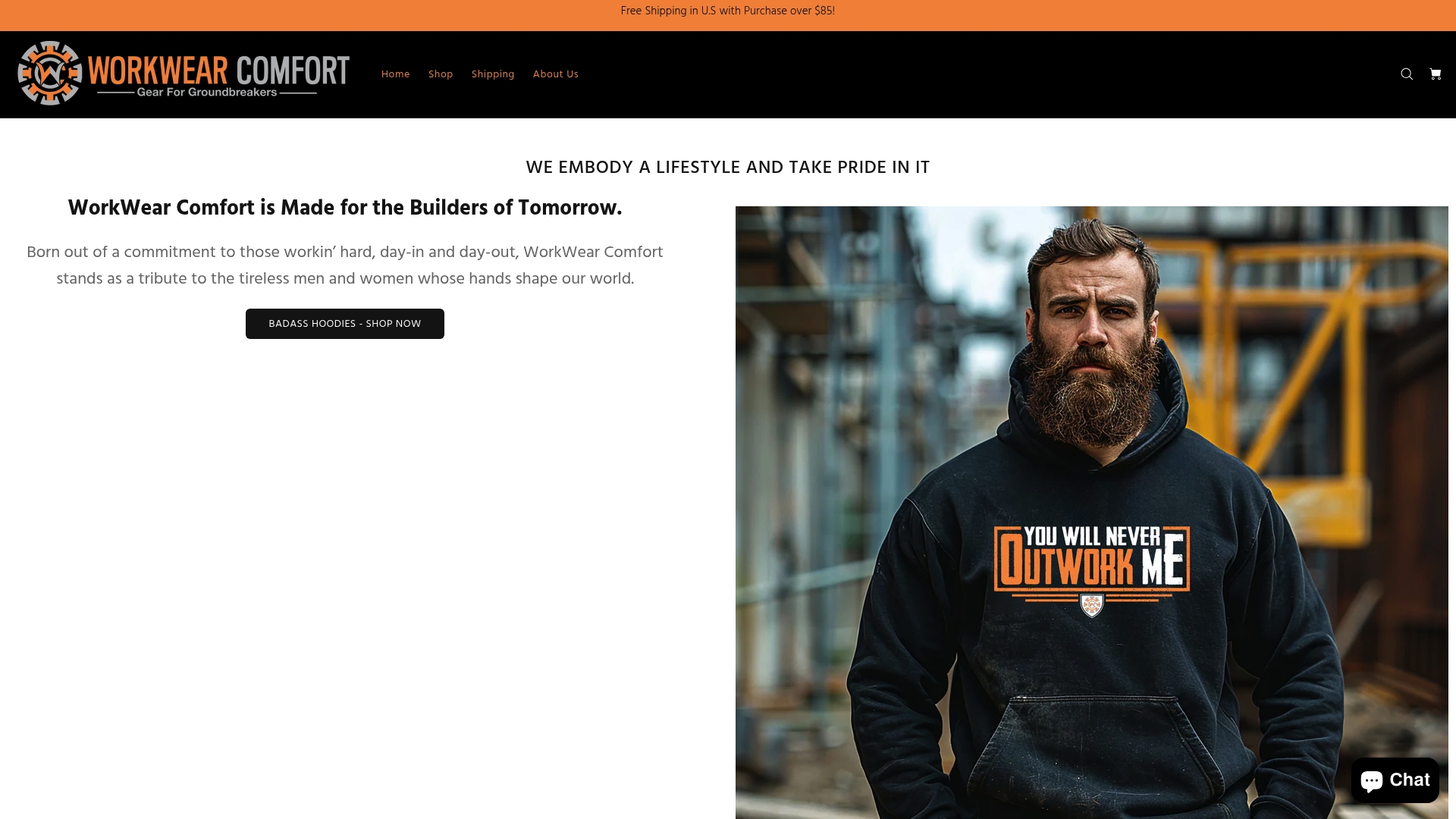
Workplace stress hits harder for tradespeople and outdoor workers than most folks realize. But there’s a surprise here. Over 80 percent of US workers say job stress is hurting their well-being, and that number climbs even higher for blue-collar jobs. You might expect toughness and grit to be enough, but the real secret is all about building support, finding the right coping strategies, and even rethinking your gear. There’s a whole side to stress relief that’s rarely talked about on the job site.
Table of Contents
- Understanding Workplace Stress In Tough Jobs
- Proven Coping Strategies For Blue-Collar Workers
- Building Support And Staying Mentally Strong
- Choosing Gear That Eases Workplace Stress
Quick Summary
| Takeaway | Explanation |
|---|---|
| Recognize and address workplace stress | Understanding that stress is systemic helps foster healthier work environments for trades professionals. |
| Implement structured work-rest cycles | Regular short breaks enhance physical recovery and mental focus, essential for managing job-related stress. |
| Foster open communication and support | Creating peer support networks improves resilience and lowers individual stress levels significantly. |
| Invest in ergonomic work gear | Selecting well-designed clothing and equipment minimizes physical strain and boosts psychological comfort. |
| Develop a personal stress management toolkit | A customized toolkit allows workers to proactively manage their mental well-being effectively. |
Understanding Workplace Stress in Tough Jobs
Tradespeople and outdoor workers face unique workplace stress challenges that go far beyond typical office job pressures. The physical demands, high-risk environments, and constant performance expectations create a perfect storm of mental and physical strain that can quickly overwhelm even the most resilient workers.
The High-Pressure Reality of Blue-Collar Work
Workplace stress is a critical issue for trades professionals, with over 80% of U.S. workers reporting significant job-related stress that impacts their overall well-being. For those in construction, agriculture, mechanical trades, and outdoor industries, the stress levels are exponentially higher. The combination of physical labor, tight deadlines, safety risks, and unpredictable working conditions creates a uniquely challenging mental health landscape.
According to the National Institute for Occupational Safety and Health, workers in high-demand jobs with low personal control are at increased risk of serious health consequences. This means tradespeople aren’t just battling daily job challenges they’re facing potential long-term cardiovascular, musculoskeletal, and psychological impacts from chronic workplace stress.
Identifying the Root Causes of Workplace Stress
The sources of stress in tough jobs are multifaceted and deeply complex. Physical exhaustion plays a significant role, with workers experiencing constant physical strain that depletes both mental and physical energy. Long hours, extreme weather conditions, complex project requirements, and the need for constant precision under challenging circumstances contribute to an overwhelming sense of pressure.
A detailed study in the International Journal of Environmental Research and Public Health revealed that construction workers experience heightened stress from multiple interconnected factors. These include high job demands, limited personal control over work processes, potential safety risks, and complex interpersonal dynamics on job sites. The research highlighted that organizational justice and worker autonomy play crucial roles in managing workplace stress effectively.

The Comprehensive Impact of Unmanaged Stress
Unmanaged workplace stress doesn’t just affect individual workers it creates ripple effects across entire teams and work environments. Persistent stress can lead to decreased productivity, increased accident rates, higher turnover, and significant mental health challenges. Workers may experience burnout, reduced job satisfaction, and potential long-term psychological consequences.
By understanding these complex stress dynamics, trades professionals can develop more effective coping strategies. Recognizing that workplace stress is a systemic issue rather than an individual weakness is the first step toward creating healthier, more supportive work environments. Learn more about professional resilience strategies that can help workers navigate these challenging professional landscapes.
Below is a summary table highlighting the main sources of workplace stress for trades and outdoor workers, along with their short-term and long-term impacts as described in the article.
| Source of Stress | Short-Term Impact | Long-Term Impact |
|---|---|---|
| Physical exhaustion | Fatigue, reduced focus | Musculoskeletal disorders |
| High job demands | Increased pressure, anxiety | Burnout, chronic stress |
| Limited personal control | Frustration, helplessness | Decreased job satisfaction, mental health risks |
| Extreme weather/environment | Discomfort, distraction | Increased accident risk |
| Safety risks | Heightened alertness, stress | Psychological trauma |
| Complex interpersonal dynamics | Miscommunication, tension | Team conflict, turnover |
The key is not to eliminate stress entirely an impossible task in demanding trades but to develop robust mental and physical strategies for managing and mitigating its most harmful effects.
Proven Coping Strategies for Blue-Collar Workers
Surviving and thriving in high-stress trades requires more than physical strength. Blue-collar workers need practical mental and physical strategies to manage workplace stress effectively, protecting both their professional performance and personal well-being.
Physical Recovery and Mental Reset Techniques
Recovery is not a luxury it’s a necessity for trades professionals. Occupational safety experts recommend structured work-rest cycles as a critical intervention for managing job-related stress. This means intentionally creating spaces for physical and mental recuperation during demanding workdays.
Effective physical recovery strategies include:
- Micro-breaks: Short 5-10 minute intervals of complete rest or light stretching
- Active recovery: Gentle movements that promote blood circulation and muscle relaxation
- Hydration and nutrition: Maintaining consistent energy levels through strategic eating and drinking
Mental reset techniques are equally important. Deep breathing exercises, mindfulness practices, and brief meditation can help workers quickly recalibrate their stress response. These methods take minimal time but provide significant psychological benefits, helping trades professionals maintain focus and emotional stability during challenging work scenarios.
Communication and Support Systems
Open communication is a powerful stress management tool. Workplace environments that encourage honest dialogue about challenges create resilience. Research indicates that workers with strong support networks experience lower stress levels and better overall job satisfaction.
Building effective support systems involves:
- Peer support groups: Creating safe spaces for workers to share experiences
- Supervisor training: Developing leadership skills focused on recognizing and addressing workplace stress
- Mental health resources: Providing accessible counseling and professional support options
Trades professionals should not view seeking help as a weakness. Instead, it represents a strategic approach to maintaining personal and professional effectiveness. Check out our guide on professional resilience for additional insights into building workplace mental toughness.
Personal Stress Management Toolkits
Developing a personalized stress management toolkit empowers workers to take proactive control of their mental health. This toolkit might include physical exercises, mental reframing techniques, and personal boundary-setting strategies.
Key components of an effective personal stress management approach include:
- Regular physical exercise
- Consistent sleep schedules
- Hobbies and activities outside of work
- Skill development for better job control
- Financial planning to reduce economic stress
Ultimately, managing workplace stress in blue-collar jobs requires a holistic approach. It’s about creating sustainable strategies that support physical health, mental resilience, and professional growth. By implementing these proven coping techniques, trades professionals can transform workplace challenges into opportunities for personal and professional development.
Building Support and Staying Mentally Strong
Mental resilience in tough jobs isn’t about being superhuman. It’s about developing practical strategies that help blue-collar workers navigate complex emotional landscapes while maintaining professional effectiveness and personal well-being.
Creating a Supportive Work Culture
Research from occupational health experts reveals that workplace mental health is deeply influenced by organizational culture. For trades professionals, this means creating environments where vulnerability is seen as strength, not weakness. A comprehensive review highlights critical factors like addressing gender inequality, improving working conditions, and reducing work overload as fundamental to building supportive workplace ecosystems.
Key elements of a supportive work culture include:
- Open communication channels: Encouraging honest dialogue about workplace challenges
- Zero tolerance for harassment: Establishing clear boundaries and accountability
- Peer support networks: Creating formal and informal support systems
Leadership and Mental Health Training
OSHA emphasizes the critical role of leadership in promoting mental health awareness. Supervisor training goes beyond traditional management approaches. It involves equipping leaders with skills to recognize stress signs, provide emotional support, and create environments where workers feel safe discussing mental health challenges.
Effective leadership mental health strategies include:
- Emotional intelligence training: Helping supervisors understand and respond to team emotional dynamics
- Stigma reduction workshops: Breaking down barriers around mental health discussions
- Practical support skills: Teaching managers how to provide meaningful assistance
Personal Resilience Development
Individual mental strength is built through intentional practices and continuous learning. This isn’t about eliminating stress but developing robust coping mechanisms that transform challenges into growth opportunities. Occupational health frameworks suggest that personal resilience is a learnable skill set involving emotional regulation, adaptive thinking, and proactive self-care.
Strategies for building personal resilience include:
- Regular self-reflection: Understanding personal stress triggers
- Continuous skill development: Enhancing professional competence
- Holistic wellness approaches: Integrating physical, mental, and emotional health practices
Check out our guide on professional strength and resilience to discover more techniques for staying mentally strong in challenging work environments.
Mental strength in blue-collar jobs isn’t about never feeling stressed. It’s about developing the tools, support systems, and personal strategies that help you navigate workplace challenges with grace, resilience, and professional integrity. By focusing on comprehensive support and individual growth, trades professionals can transform potential mental health obstacles into opportunities for personal and professional development.
Choosing Gear That Eases Workplace Stress
In tough trades and outdoor jobs, the right gear is more than just protection it’s a critical tool for managing workplace stress. Strategic clothing and equipment selections can significantly reduce physical strain, improve comfort, and ultimately support mental well-being.
Ergonomic Design and Stress Reduction
OSHA research highlights that appropriate personal protective equipment (PPE) and work clothing play a crucial role in minimizing physical stress and fatigue. The right gear isn’t just about meeting safety standards it’s about creating a work environment that supports worker comfort and reduces unnecessary physical challenges.
Key ergonomic considerations include:
- Flexible material selection: Clothing that moves with the body
- Weight distribution: Gear that minimizes muscle strain
- Breathable fabrics: Materials that regulate body temperature
Ergonomic design goes beyond comfort. Research in occupational health demonstrates that well-designed work gear can directly impact psychological stress levels. When workers feel physically supported, their mental resilience increases.
Climate and Environment Adaptive Gear
Outdoor and trades professionals face extreme and unpredictable working conditions. Gear that adapts to these environments becomes a critical stress management tool. This means selecting clothing and equipment that provide protection without creating additional physical discomfort.
Stress-reducing environmental gear strategies include:
- Layering systems: Clothing that allows quick temperature adjustments
- Sun protection: UPF-rated fabrics that prevent heat and UV stress
- Waterproof and windproof options: Maintaining comfort in challenging weather
Personal Fit and Psychological Comfort
Beyond technical specifications, gear selection is deeply personal. Explore our comprehensive guide to professional workwear to understand how the right clothing can transform your work experience.
Psychological comfort in work gear involves:
- Size and fit customization: Clothing that feels like a second skin
- Color and design preferences: Gear that boosts personal confidence
- Functional pockets and storage: Reducing daily logistical stress
Choosing the right gear is an investment in personal well-being. It’s about creating a protective environment that supports both physical performance and mental resilience. By selecting thoughtfully designed workwear, trades professionals can turn their clothing from a simple necessity into a powerful stress management tool.
The following table summarizes the main ergonomic, environmental, and psychological factors to consider when choosing work gear to reduce workplace stress, as discussed in the article.
| Gear Feature | Stress-Reducing Benefit | Example/Details |
|---|---|---|
| Flexible materials | Reduces physical strain | Clothing that moves with the body |
| Weight distribution | Minimizes muscle fatigue | Balanced load-carrying equipment |
| Breathable fabrics | Regulates body temperature | Promotes comfort during strenuous work |
| Layering systems | Adapts to changing climates | Enables quick temperature adjustments |
| Sun/water/wind protection | Lessens weather-related discomfort | UPF-rated, waterproof, windproof gear |
| Size and fit customization | Boosts psychological comfort | Ensures clothing feels personalized |
| Functional pockets/storage | Reduces logistical stress | Streamlines access to tools and essentials |

Remember, the best gear doesn’t just protect you from external elements. It supports your entire work experience, helping you stay focused, comfortable, and mentally strong throughout even the most challenging workdays.
Frequently Asked Questions
What are some effective strategies for managing workplace stress in trades and outdoor jobs?
Implementing structured work-rest cycles, fostering open communication and support systems, and developing a personal stress management toolkit can significantly help manage workplace stress.
How can ergonomic gear reduce stress for tradespeople?
Ergonomic gear is designed to minimize physical strain, improve comfort, and enhance productivity, which in turn can reduce mental stress associated with discomfort or fatigue while working.
What role does communication play in coping with job-related stress?
Open communication creates trust and support among workers, allowing them to share challenges and solutions. This can lead to lower stress levels and improved job satisfaction.
How can outdoor workers protect themselves from environmental stressors?
Choosing climate-adaptive gear, such as layering systems and sun protection, helps outdoor workers manage the physical stress caused by extreme weather conditions.
Upgrade Your Workwear, Lower Your Stress
Are you feeling the impact of constant physical wear, unpredictable weather, and mental fatigue on the job? Like the article highlights, long hours and unsafe gear can quietly add to your stress and cut into your ability to stay sharp and healthy. At WorkwearComfort.com, we believe no one should have to battle uncomfortable clothing or gear that lets them down. You deserve to feel supported, protected, and confident every time you step onto the site or the field.

It’s not just about safety or compliance. The right gear removes unnecessary stress, helps prevent fatigue, and gives you room to focus on your craft. Our durable workwear and UPF 50+ sun-protective hoodies are designed to meet the exact challenges discussed in this article, with styles tailored for both men and women. If you’re searching for rugged clothing that works as hard as you do, now is the time to find your perfect fit. Visit WorkwearComfort.com and experience how high-quality work apparel can help you manage workplace stress and power through your toughest days.
Recommended
- Top Trades Gear and Apparel for 2025: Rugged Choices - WorkWear Comfort
- Women in the Trades 2025: Durable Workwear and Strong Careers - WorkWear Comfort
- Best Workwear for Hot Weather: Stay Cool & Protected in 2025 - WorkWear Comfort
- What Is Workwear? A 2025 Guide for Hardworking Professionals - WorkWear Comfort


